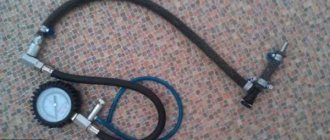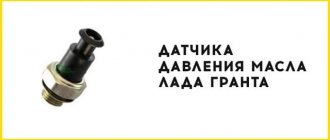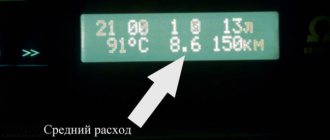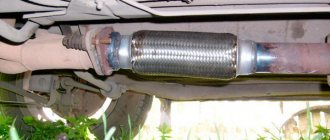What is a fuel pressure regulator?
The fuel pressure regulator (FPR) is a vacuum valve; it transfers excess fuel through a return hose into the fuel tank. The RTD is a housing that contains a valve, a membrane and a spring. There are also three terminals in the housing: two terminals for the passage of fuel through the regulator, the third is connected to the intake manifold. As engine speed increases, the vacuum created in the manifold (at the third terminal) overcomes the force of the spring and moves the membrane, thereby opening the valve slightly. Excess fuel gets access to the second outlet and goes back to the gas tank. An RTD is often also called a check valve.
As a rule, the check valve is located on the fuel rail; it can also be embedded in the fuel return hose of the power supply system.
Causes of fuel pressure regulator malfunctions
RDT may fail for several reasons. For example, defective parts are found on Russian-made cars. There are significantly fewer defects on foreign models, but you can purchase a defective RTD by purchasing a non-original spare part.
Mostly the check valve breaks down due to natural aging. Let's say this can happen after a hundred thousand mileage or more. It should be noted that check valve failures are not common. Most often, in an RTD, the membrane dries out over time, less often the valve jams, and even less often the spring breaks or weakens.
Sensor failure may occur due to low-quality gasoline. For example, in winter, fuel was filled with water, and water got into the regulator. If the fuel filter is not replaced on time, dirt gets into the parts of the power system, including the regulator. In this case, the RTD valve most often jams. It’s hard to imagine what could happen to the spring, but apparently, it still breaks sometimes.
Failure options
The regulator is a simple device from a technical point of view, so there are few breakdowns that can happen to it. In almost all cases it is recommended to replace the RTD.
What can break:
- Spring. This is the main failure in the RDT. Due to the weakening of the spring, the engine becomes “starved”, there is not enough fuel at high speeds, when the clutch is pressed and during transient conditions.
- Pollution. When clogged, the ability to pass fuel is lost. The engine stops in any operating mode. If the RTD is heavily contaminated, the pressure in the vehicle rises sharply and fuel leaks through the sealing material. The problem is solved by pumping a large amount of fuel into the fuel pump.
- Jammed. The RTD in the ramp may periodically jam. The car twitches.
Characteristic symptoms of fuel pressure regulator malfunctions
By what signs can you determine that an RDT is not working:
- the engine is very difficult to start, you need to turn the starter for a long time and at the same time keep the gas pedal pressed in order for the engine to start;
- The engine idles unsteadily or the speed is very low, the engine often stalls. At the same time, it does not gain power at all; when trying to accelerate, it results in a deep failure;
- The spam engine changes speed sharply, this is especially noticeable at idle:
- Fuel is leaking from the fuel hoses. Attempts to tighten and replace clamps and replace hoses do not help.
How to check the fuel pressure regulator for serviceability
The fuel pressure regulator is not an electrical sensor and cannot be checked using instruments. It should also be taken into account that the RDT cannot be disassembled or repaired. Someone writes that the fuel check valve can be repaired. I would like to see what it looks like and where you can buy a repair kit. Typically, RTDs are inexpensive, and even for that reason they would not be worth repairing if they were repairable.
You can verify that the regulator is working properly by checking the pressure in the fuel system. This is usually done with a mechanical pressure gauge, which is connected to the engine power system.
Measurement is carried out as follows:
- connect the pressure gauge to the fuel system;
- start the engine and look at the pressure gauge readings.
The standard system pressure for a passenger car is usually within 3 kg/cm2. When stopping the engine, the pressure should not drop immediately - the regulator closes the return flow. If the pressure gauge needle quickly goes to zero, the RTD is most likely faulty.
Another way to check: if you manage to pinch the fuel return hose while the engine is running, then if the regulator is working properly, the pressure in the fuel system should increase. The indication of the arrow of the device depends on the degree of compression. But there are foreign cars where it is impossible to clamp the return line - instead of rubber hoses there are metal tubes, or the hoses are very short.
In some cases, by squeezing the return hose, you can verify that the RTD is faulty without a pressure gauge. But this is only due to one sign - when the engine idles and does not develop speed at all. If, when the return line is compressed, all cylinders begin to work and the engine acquires the required power, then the RTD is definitely faulty and needs to be replaced.
WE REPAIR
Restoring the pump's functionality can only be done by a specialized workshop with qualified personnel and diagnostic equipment. The cost of repairs is from 7 thousand rubles, then it depends on the complexity. In case of some damage, it is wiser to buy a new injection pump. The usual price, about 30 thousand rubles, will shock the tight-fisted diesel operator, which is why repaired or restored products are in use.
A CR diesel with high mileage is often impossible to start due to a malfunction of at least one of the injectors. Fuel leakage through its valve does not allow the pressure in the rail to rise to starting values. There is a special diagnostic kit to check the pressure at start-up. It includes a control pressure gauge, a pressure sensor, connection tubes, plugs instead of actuators and backflow measuring containers.
Operating principle of the fuel pressure regulator
To understand how a fuel pressure tester works, you need to know how it works. It consists of the following parts:
- Fuel pump;
- Pressure regulator;
- Electronic control unit pump;
- Fuel lines;
- Baka;
- Fuel filter;
- Injectors;
- Inertia switch.
Thanks to its design, the regulator controls and maintains the same fuel pressure relative to atmospheric pressure. Where is the fuel pressure regulator installed? Install it in the fuel tank.
Features of the device for monitoring fuel pressure in a system with fuel recirculation
The RTD is divided by a membrane into two chambers:
The valve holder itself is connected to the membrane and presses the valve to the seat. The fuel pressure, which is supplied to the chamber through special inlet passages, acts on the membrane from below. The pressure of the spring and the intake manifold acts from above. Sometimes the pressure can exceed the spring force. In this case, the valve is opened slightly, allowing gasoline to flow into the return pipeline. In this case, the pressure in the intake manifold must be taken into account.
During operation of the fuel pump, fuel leaves the tank, heading towards the filter. There it is cleaned and goes to the regulator. The regulator maintains the effective pressure in the system without stopping. The main thing is that all actions must occur correctly.
The device itself is located inside a steel case. It must also be able to withstand high pressure. The device mechanism itself consists of a diaphragm and also has a check valve. It prevents the fuel, which is under pressure, from returning to the line.
Car won't start after DIY replacement
This is a fairly common problem. It must be said that the car should not start immediately after replacing the pump. The pump first needs to create operating pressure in the system. To do this, you need to turn on the ignition for a short time (a few seconds). The key must be inserted into the lock, but not turned. The lights on the dashboard should light up. Then you can rotate the engine with the starter for five to ten seconds. If nothing works out, then you should take a break for half a minute and repeat your actions.
We recommend: Niva transfer case. Ways to eliminate vibration
If the engine does not start even after several cranks with the starter, this indicates that shortcomings were made during assembly and connection of the fuel pump. Another reason could be a malfunction of the new pump. There is also a possibility of a planned blocking or failure of the car’s security system.
When a car owner installs and connects a new unit, various failures may occur: sticking of valves on the pump, breakage of contacts, terminals and connectors. When such problems arise, you need to try to determine their nature. Did the breakdown occur in the mechanical or electrical part of the fuel pump? The easiest way to find out is if there is a problem with the power supply. You also need to remember that the fuel filter may become clogged.
In order to accurately determine the causes of the problems, you need to make sure that the fuel rail does not contain gasoline. After this, you need to re-remove and connect the pump directly from the battery or dimensions. This method of connecting the pump is the best for quickly checking it.
A car owner must take care of every part of the car. It is best to gain knowledge about its structure and repair yourself. It is important to acquire skills in diagnosing and solving problems in the operation of individual machine systems. This also applies to the functioning of the fuel pump.
Many drivers encounter breakdowns on the road, far from cities and service points. In such a situation, you can only rely on your own experience. Knowledge about the signs and causes of malfunctions in the fuel pump will help solve problems at the initial stage of their occurrence. It will also save effort, time and a significant part of personal funds.
How does the fuel pressure regulator work? RTD operating mode
It must be remembered that the level of fuel pressure in the ramp itself depends on the vacuum in the suction manifold: the less discharge, the greater the pressure. The main mode of operation of the regulator is idle. Just at the moment of operation at this speed, the vacuum begins to reach a low point, and the pressure level in the fuel rail leads to the highest indicator. This value is applied to the regulator body in order to correctly monitor pressure during diagnostics of the supply system.
Important: if the pressure regulator cannot be repaired, it should be replaced with a new one. To avoid this, it is necessary to check it as often as possible and monitor the pressure. This will allow you to avoid breakdowns in time and save your money on purchasing another pressure regulator. There is no guarantee that the new regulator will not avoid such problems.
Important: despite the operating mode of the engine, the RTD must always respond to changes in it
The role of the fuel regulator in the car system
At different engine operating modes, it is necessary to create the appropriate fuel pressure in the fuel system. To implement this task in practice, a special pressure regulator is used. It is used in injection engines, where the correct operation of the engine depends on the accuracy of the injection parameters.
When the governor is faulty, the engine runs unevenly, acceleration times are increased, and in some cases power can be significantly reduced. So, for example, if the amount of air coming from the manifold remains unchanged, and there is more fuel than necessary, the air-fuel mixture will not ignite or will not burn completely.
Even if in this mode the electronic control unit shortens the injector opening interval, it will not be possible to completely compensate for the excess fuel pressure. This will lead to interruptions in engine operation and an increase in the amount of unburned fuel in the exhaust, which can prematurely damage the catalytic converter or particulate filter.
Signs of a malfunctioning fuel pressure regulator
Over time, the spring in the regulator may sag without creating the necessary force. The fuel will begin to return back to the tank. This will cause a decrease in pressure in the fuel rail. Such a breakdown will lead to a lack of fuel and loss of power in the engine.
If the valve is jammed, the pressure level in the fuel frame will change differently each time. In this case, the engine will not operate regularly, and the car will twitch during acceleration.
The main symptoms of a malfunctioning fuel pressure regulator :
- Uneven engine operation;
- Stopping the engine at idle;
- A sharp increase or strong drop in the crankshaft speed at idle;
- Loss of motor power;
- Poor vehicle acceleration when shifting gears;
- Poor response to the gas pedal;
- Car choking when driving, frequent jerking;
- A sharp increase in consumption.
If you detect at least one of the above symptoms, you should immediately check the device.
Causes of malfunction of the fuel pressure regulator in a car
Cause
What is a malfunction?
The most common malfunctions include mechanical damage to the parts of this unit or clogging in its part. This leads to a malfunction of the fuel pressure check regulator. Such damage may be associated with the obsolescence of the materials from which the mechanism itself is made. In this regard, the pressure regulator returns to normal, but its operation no longer meets standard indicators. For example: vacuum disturbances occur in its closed cavity, which makes it impossible for the engine speed controller to control the engine speed. A weakened inner spring causes low fuel line pressure.
How to check the fuel rail? Checking the RTD yourself
Checking the fuel pressure regulator is carried out to identify malfunctions or for prevention. Such checks are carried out based on the recommendations of the car manufacturer. But still, how to check the pressure in the fuel rail? Basically, the check consists of inspecting and checking the pressure of the fuel system at various engine speeds. Then comparisons are made with indicators that correspond to the norm.
It is necessary to carefully inspect the tightness of the connections, the condition of the vacuum hose, as well as the regulator itself. If no damage or defects are found, then the regulator is dismantled by completely disassembling it. If a blockage is detected in this unit, it is washed.
Important: the pressure in the fuel rail should be diagnosed using a pressure gauge. It is connected to a special diagnostic fitting.
How to check the fuel pressure regulator. Diagnostic tools regulate fuel pressure
You can also check the regulator yourself. To do this, you do not need to use any special tools or have any special auto mechanic skills. You will need to pinch or disconnect the valve and observe the force of the jet. Or for a better check, use a pressure gauge.
To measure the RTD pressure in the engine when turning on idle speed, it is worth connecting a pressure gauge, installing it between the fuel hose and the fitting. Don't forget to disconnect the vacuum hose. Below we will look at what pressure should be in the fuel rail of a VAZ 2110.
How do malfunctions of the fuel pressure regulator affect engine performance?
A faulty regulator valve affects not only operation, but also the very start of the engine. If the device is working properly, the pressure in the fuel rail does not drop after the engine stops. If the valve has a malfunction, then the pressure in the fuel rail drops when the engine stops. The engine will not start until the sediment has completely filled the system. And only after reaching the desired level, the first engine start signals may appear. Here everything will depend on the power of the battery. Otherwise, the engine will not be able to start. Therefore, if the pressure in the fuel rail does not hold, this indicates a malfunction!
In addition to the above, gas failures may occur during acceleration of the car, unstable idling, and a general weakening of engine power will begin to appear.
WE DIAGNOSE
There is a minimum of equipment without which it is unreasonable to start working. Diagnostics of electronic systems begins with reading fault codes, checking sensors and actuators. There are no special diesel scanners, there are universal ones, that is, for a wide range of cars, or dealer ones - for a specific brand. To study the signal from the device under test, you need an oscilloscope. But it is expensive; it is more profitable to buy a scanner with an additional oscilloscope function.
Fuel pressure is checked with pressure gauges. Low - mechanical, with a scale of up to 10 bar, and high - with a special device with adapters and a range of at least 2000 bar. And to measure the amount of fuel drained from the injectors, you need your own set.
The troubleshooting algorithm depends on the nature of the failure. If the engine does not start (electronic locks and forgotten secrets do not count), we check the integrity of the timing drive. If the starter rotates the crankshaft with force, this is not bad for the owner, but if without resistance, the repairmen will be happy: the work ahead will be expensive. After all, diesel engines are “plug-in” - when the timing drive is destroyed, the pistons bend the valves, and then whatever happens.
Replacing the fuel pressure regulator in az 21 10 (and other cars)
To ensure that your car is always on the road and there are no problems with the fuel pressure regulator, you need to take the time for a thorough inspection.
1) Under the hood of the car, open the fitting plug, which is responsible for controlling the fuel pressure at the end.
2) Take a special protective metal cap and carefully unscrew the spool from the inner cavity of the fitting.
3) Then attach a hose with a pressure gauge to it. Secure it to the fitting using a clamp. After this, you should start the engine and check the pressure shown by the pressure gauge. It should not be higher than 325 kPa ( 3.25 Bar ).
4) Carefully disconnect the vacuum hose from the pressure regulator. You will immediately see how the pressure will increase on the pressure gauge. If this does not happen, you should replace the device with a new one. A device that has not been repaired cannot be repaired. But how to change the fuel pressure regulator?!
5) Now you can slightly reduce the pressure in the power system and remove the vacuum hose from the RTD. To do this, you will need to unscrew the reinforcing nut on the fuel drain pipes to the pressure regulator.
6) You need to unscrew the two bolts securing the device to the fuel rail.
7) Now you can remove the regulator from the fuel drain pipe itself. If the ring does not immediately detach and remains in the ramp, remove it. It is put on the regulator before installation. The regulator must be installed in the reverse order, observing the exact sequence.
So now you know the causes of fuel pressure regulator failure and how to replace the fuel pressure regulator. The most important thing is not to rush, and follow the sequence of actions.
Fuel pressure regulator (FPR) is part of the system that supplies the injection engine. This element maintains the fuel pressure in the injectors under various operating modes of the internal combustion engine. The regulator actually plays the role of a diaphragm valve, ensuring good performance and stable operation of the injectors and motor. It is important to know how the pressure sensor works and the signs that indicate its malfunction.
Other spare parts for Kia CARNIVAL
› Seat headrest › Brake drum assembly › Nut m › Washer mm › Lock nut › Inner sill panel › Catalytic converter assembly › Heated right electric mirror › Oil filter › Automatic transmission retaining ring › O-ring › Bolt m › Shoulder bolt › Door stop › Bolt m › Bolt m › Alternator › Fuel filler door panel latch › Tie rod castle nut › Tailgate inner panel › Bolt m › Roof panel trim fastener › Screw m3 › Technical information sticker › Screw self res m › Fitting cap › Gearbox lever support › Clutch fork retaining ring › Interior flooring x cm › Sensor-camshaft position, rh
| Hyundai Accent Hyundai Aero City Hyundai Aero Queen / Express Hyundai Aero Space Hyundai Aero Town Hyundai Atos Hyundai Atos Prime Hyundai Azera Hyundai Centennial Hyundai Chorus Hyundai County Hyundai Coupe Hyundai Elantra Hyundai Elantra New Hyundai Elantra XD Hyundai Entourage Hyundai Equus Hyundai Excel Hyundai Galloper Hyundai Genesis Hyundai Genesis Coupe Hyundai Getz Hyundai Global 900 Hyundai Grandeur Hyundai H-1 Starex Hyundai H100 Porter Hyundai HD 120 Hyundai HD 160 / 170 Hyundai HD 250 / 260 Hyundai HD 65 / 72 Hyundai HD 78 Hyundai HD35 / 75 Hyundai HLD150 Hyundai HMD230 / 260 Hyundai i10 Hyundai i20 Hyundai i30 Hyundai ix35 Hyundai ix55 Hyundai Lantra Hyundai LaVita Hyundai Libero Hyundai Marcia Hyundai Matrix Hyundai Mighty Hyundai New Power Truck Hyundai Pony Hyundai Santa FE Hyundai Santa FE Classic Hyundai Santamo Hyundai Santro Hyundai SCoupe Hyundai Sonata Hyundai Sonata NF Hyundai Sonata YF Hyundai Stellar Hyundai Terracan Hyundai Tiburon Hyundai Trajet Hyundai Tucson Hyundai Universe Space Hyundai Universe Xpress Hyundai Veracruz Hyundai Verna Hyundai XG Hyundai 11 ton truck Hyundai 23 ton truck Hyundai 5 ton truck Hyundai 8 ton truck Hyundai 8 ton upper truck | Kia AVELLA Kia BESTA Kia BORREGO Kia CAPITAL Kia CARENS Kia CARNIVAL Kia CEED Kia CERATO Kia CLARUS Kia CONCORD Kia ELAN SPORT Kia ENTERPRISE Kia JOICE Kia K2700 Kia MAGENTIS Kia OPIRUS Kia OPTIMA Kia PICANTO Kia POTENTIA Kia PRIDE Kia RETONA Kia R IO Kia ROADSTER Kia SEDONA Kia SEPHIA Kia SHUMA Kia SORENTO Kia SOUL Kia SPECTRA Kia SPORTAGE Kia VENGA Kia VISTO Kia Pregio Kia Mohave Kia Amanti Kia Mentor Kia Bongo Kia Power Combi Kia AM928 Kia Ceres Kia Cosmos Kia Towner Kia Granbird Kia Credos Kia Rondo Kia Rhino Kia Mighty B-Body Kia K2500 Kia K3000 Kia K3600 | Chevrolet AVEO Chevrolet CAPTIVA Chevrolet EPICA Chevrolet EVANDA Chevrolet HHR Chevrolet LACETTI Chevrolet LANOS Chevrolet LEGANZA Chevrolet REZZO Chevrolet SPARK Chevrolet CRUZE | Daewoo DAMAS Daewoo ESPERO Daewoo EVANDA Daewoo KALOS Daewoo LANOS Daewoo LEGANZA Daewoo MATIZ Daewoo NEXIA Daewoo NUBIRA Daewoo TACUMA Daewoo TICO | SsangYong ACTYON SsangYong ISTANA SsangYong KORANDO SsangYong KYRON SsangYong MUSSO SsangYong REXTON SsangYong RODIUS SsangYong ACTYON SPORTS SsangYong CHAIRMAN SsangYong MUSSO SPORTS |
Purpose of the regulator
The sensor maintains the optimal pressure in the fuel rail, necessary for the correct operation of the injectors in different operating modes of the unit. The RTD determines the intensity of fuel supply and its quantity. Fuel enters the engine cylinders through the injectors.
Dosing accuracy and maintaining the required pressure is ensured by a membrane control valve, onto which springs press at one end and fuel at the other. There are two options for placing an element:
- The RTD is used in power systems with a check valve and is mounted on the fuel rail.
- In designs without “return”, the sensor is installed on the fuel tank.
In the first case, the fuel pump pumps fuel through the line from the tank. The resulting pressure affects the regulator. The device contains two chambers: fuel and spring, which are delimited by a membrane.
Possible faults
Failures in the power system can occur for various reasons. Therefore, when diagnosing, you need to take into account some features of a regulator failure and symptoms of low fuel pressure. The main features include:
- reduced power, high fuel costs;
- dips and jerks during acceleration and throttle change;
- unstable operation and engine shutdown at idle;
- slow car response when adding gas;
- The car does not pick up speed and does not accelerate.
Signs of low pressure in the RTD on gasoline cars are similar to symptoms of a malfunction in the fuel pump or a broken fuel filter. The system stops working correctly due to loss of spring force. In this case, the fuel does not reach the required level and goes into the check valve. As a result, the engine does not have enough fuel to accelerate and increase speed. Low pressure in the sensor reduces engine power. The electronic control system cannot optimally adjust the fuel for different modes.
Another cause of failure could be a clogged RTD or reduced throughput.
In this case, the engine stalls in any operating mode. A clogged regulator can lead to an excessive increase in pressure and fuel overflow through the connections of the sealing elements.
The fuel pump always takes in fuel with some reserve to prevent a possible decrease in the performance of the injectors and sensor. Therefore, if it is difficult to drain fuel into the return valve, the pressure in the system increases.
Periodic jamming of the pressure regulator also leads to failures.
The car begins to move jerkily, pressure drops occur in the sensor. The cause of the breakdown may also be wear of the valve inside the device. Its service life can be shortened by low-quality fuel with impurities, or by keeping the machine idle for a long time without starting the engine.
Signs of sensor failure
In all cars produced after 2000, the RTD is integrated into the engine control unit and in case of any malfunction, a “Check” will light up on the dashboard. There are old diesel engines that are equipped with mechanical regulators; diagnostics of the elements is carried out as planned or after a malfunction of the internal combustion engine occurs. Characteristic symptoms of a faulty sensor:
- In addition to the “Check Engine” signal, the following error codes appear: P0190-P0194.
- A sharp decrease in internal combustion engine power, loss of traction, is often detected during overtaking; the car does not have the power to dynamically accelerate even up to 120 km/h.
- Excessive fuel consumption.
- The car starts poorly, regardless of whether the engine is warmed up or not.
- Diesel internal combustion engines are characterized by the appearance of dips at high speeds, when the engine does not respond to speed reduction.
Checking an element
In most cases, if problems are detected, it is better to completely replace the fuel pressure regulator. Changing individual elements, cleaning and other manipulations cannot always restore the required performance to the device. The affordable price of the RTD also contributes to the decision to completely replace the component.
The easiest, most accessible and effective way to check the regulator is to measure the indicators using a tire pressure gauge. To determine the idle pressure, the device is connected between the fitting and the fuel system hose. The measurements must indicate pressure within a certain range. The vacuum hose is then disconnected.
As the pressure increases, the indicator should be between 0.3−0.7 Bar. If the value is outside this range, install a new vacuum hose and repeat the test in the following order:
- The fuel pressure on the end area of the ramp is determined after unscrewing the fitting plug. It is also necessary to check the O-ring for integrity and elasticity. If there are defects, then the element or the entire plug must be replaced.
- The umbrella is unscrewed from the fitting; for this you can use a metal valve cap. A hose with a pressure gauge is connected to the part and secured with clamps. After this, the engine is started and measurements are taken. Indicators within the normal range are 2.9−3.3 kgf per square meter. cm.
- The hose is disconnected from the regulator. You need to check the pressure gauge readings; the pressure should increase to 20−70 kPa. If the value remains low or zero, the device must be replaced.











